|
|
|
Sort Order |
|
|
|
Items / Page
|
|
|
|
|
|
|
| Srl | Item |
| 1 |
ID:
142609
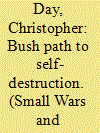

|
|
|
|
|
| Summary/Abstract |
This article explains the demise of Sierra Leone's Revolutionary United Front (RUF) rebellion. It argues that the main cause of this fate was the group's relationship with its primary sponsor, Charles Taylor. The RUF's dependency on Taylor's patronage, coupled with the rebellion's weak organisational endowments harmed the group's prospects of success. Based on original research, the article shows how Taylor used the RUF as a strategic instrument for his own regional interests, which led to the group's unravelling. More broadly, the article speaks about proxy warfare in Africa and how the relationship between resource flows and rebellion are not always beneficial to rebels as one might expect.
|
|
|
|
|
|
|
|
|
|
|
|
|
|
|
|
| 2 |
ID:
181635
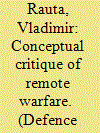

|
|
|
|
|
| Summary/Abstract |
This paper presents a conceptual critique of “remote warfare.” It argues that “remote warfare” is more of a trendy term than a robust concept. In support of this assessment, this paper makes two arguments. First, that there is a lack of clarity in the debate over what “remote warfare” is: namely, the literature is yet to explain what it entails. Second, that because of this lack of definitional specificity, we also lack an account of its analytical value: what intellectual leverage does it hold over existing terms making similar claims? The article discusses these points by expanding on the notion of “semantic field,” which it uses to assess how “remote warfare” contributes and is shaped by the broader conceptual confusion in the study of contemporary war and warfare.
|
|
|
|
|
|
|
|
|
|
|
|
|
|
|
|
| 3 |
ID:
146228
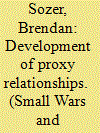

|
|
|
|
|
| Summary/Abstract |
Proxy warfare is a consistent element in international warfare. However, it is unclear why proxy relationships form in cases where states have multiple options of groups to support. Existing research identifies the presence of transnational constituencies, shared interstate rivalries, and moderate relative strength of militant groups as highly influential on the development of a proxy relationship. This study examines the presence of these variables within the context of the Lebanese Civil War. The results of this demonstrate that each state places greater importance on some variables and ignores others when choosing a proxy. Additionally, this study further demonstrates the presence of new variables that are key to the development of proxy relationships.
|
|
|
|
|
|
|
|
|
|
|
|
|
|
|
|
| 4 |
ID:
178559


|
|
|
|
|
| Summary/Abstract |
Between 1978 and 1992, Sikh militants rampaged across the northern Indian state of the Punjab demanding that a homeland for Sikhs, called Khalistan, be carved from that state. The so-called Khalistanis, with Pakistan’s extensive support, waged a brutal campaign of violence that killed tens of thousands. While Indian security forces eviscerated the various Khalistani groups by 1992, support for the movement remained strong in pockets of the global Sikh diaspora. Pakistan’s intelligence agency, the ISI, also worked to keep the movement alive wherever possible. Pakistan’s efforts have paid off: in recent years, the Khalistan movement has rehabilitated itself even within India. We constructed a novel dataset of Khalistani terror incidents perpetrated in the last decade. These data demonstrate the revivification of Khalistani terrorism, with perduring support from the ISI, which has engineered connections among Khalistani activists, militants operating in Kashmir, and narcotics traffickers. We argue that the renaissance of Khalistan is part of Pakistan’s strategy to wage proxy warfare under its nuclear umbrella as a substitution strategy for its use of Islamist proxies, such as Lashkar-e-Tayyaba and Jaish-e-Mohammad, which has become more constrained by international pressure.
|
|
|
|
|
|
|
|
|
|
|
|
|
|
|
|
| 5 |
ID:
183149
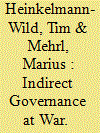

|
|
|
|
|
| Summary/Abstract |
Instead of attacking their adversaries directly, states often do so indirectly by supporting rebel groups. While these support relationships vary considerably, existing research lacks a comprehensive account thereof. To explain states’ choice of support, we suggest differentiating between two modes of support relationships according to the control opportunities they offer states over rebels: while delegation enables “hands-on” control, “hands-off” orchestration allows for plausible deniability and does not harm rebels’ local legitimacy. We argue that sponsors prefer orchestration when “hands-on” control can be substituted by goal alignment or competition; and they prefer delegation when the conflict is highly salient. Tests using global data for the period 1975-2009 support the first two expectations. Surprisingly, states’ capabilities also render “hands-off” orchestration more likely. The paper advances the understanding of external rebel support by transferring insights from indirect governance theory to the study of indirect wars and putting it to statistical test.
|
|
|
|
|
|
|
|
|
|
|
|
|
|
|
|
| 6 |
ID:
154332
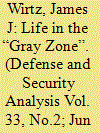

|
|
|
|
|
| Summary/Abstract |
The term “Gray Zone” is gaining in popularity as a way of describing contemporary security challenges. This article describes the “short-of-war” strategies – the fait accompli, proxy warfare, and the exploitation of ambiguous deterrence situations, i.e. “salami tactics” – that are captured by the term and offers several explanations for why state and non-state actors are drawn to these strategies. The analysis highlights why defense postures based on deterrence are especially vulnerable to the short-of-war strategies that populate the “Gray Zone.” The article concludes by suggesting how defense officials might adapt defense policies to life in the “Gray Zone.”
|
|
|
|
|
|
|
|
|
|
|
|
|
|
|
|
| 7 |
ID:
168313
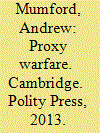

|
|
|
|
|
| Publication |
Cambridge, Polity Press, 2013.
|
| Description |
ix, 141p.pbk
|
| Series |
War and Conflict in the Modern World
|
| Standard Number |
9780745651194
|
|
|
|
|
|
|
|
|
|
|
|
Copies: C:1/I:0,R:0,Q:0
Circulation
| Accession# | Call# | Current Location | Status | Policy | Location |
| 059739 | 355.02/MUM 059739 | Main | On Shelf | General | |
|
|
|
|
| 8 |
ID:
122242
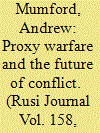

|
|
|
|
|
| Publication |
2013.
|
| Summary/Abstract |
The contemporary dynamics of proxy warfare will make it a significant feature of the character of conflict in the future. Andrew Mumford identifies four major changes in the nature of modern warfare and argues that they point to a potential increase in the engagement of proxy strategies by states: the decreased public and political appetite in the West for large-scale counter-insurgency 'quagmires' against a backdrop of a global recession; the rise in prominence and importance of Private Military Companies (PMCs) to contemporary war-fighting; the increasing use of cyberspace as a platform from which to indirectly wage war; and the ascent of China as a superpower.
|
|
|
|
|
|
|
|
|
|
|
|
|
|
|
|
| 9 |
ID:
173320
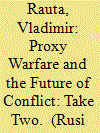

|
|
|
|
|
| Summary/Abstract |
While proxy wars have been around since time immemorial, the last decade of conflict has seen a rise in their strategic appeal. In the same way that sub-state violence captured the attention of policymakers and academics at the end of the Cold War, proxy wars are now a core feature of the contemporary and future strategic and security environment. Vladimir Rauta argues for a relocation of proxy wars by conceptualising them as strategic bargains waged on more complex grounds than risk avoidance, cost efficiency and deniability. He identifies two types of strategic goals sought through the employment of proxies: coercing and coping with an adversary, the differences of which are presented by contrasting the rationale for the US decision to support Syrian rebels against President Bashar Al-Assad with the Iranian strategy of proxy war in Syria.
|
|
|
|
|
|
|
|
|
|
|
|
|
|
|
|
| 10 |
ID:
188136


|
|
|
|
|
| Summary/Abstract |
This article examines the United Arab Emirates’ (UAE’s) involvement in proxy warfare in the Middle East and the Horn of Africa. The UAE’s security posture in these volatile regions has evolved remarkably over the last two decades and set the Emirates apart from many of its rivals, peers, and neighbors, such as Qatar, Saudi Arabia, and Turkey. Most countries have intervened in conflicts in order to affect politics in the center, either by backing pro-government militias or center-seeking rebel groups. The UAE, in contrast, has constructed a portfolio of proxy relationships mostly with separatist groups. Such groups operate in far flung peripheral territories of countries like Yemen, Iraq, Syria, and Somalia. They do not seek to seize the state, but to break away from it. This approach to proxy warfare has granted the UAE unique negative control at relatively little cost. Through its proxy networks, the UAE can impede adversaries from consolidating control across the Indian Ocean littoral and maintain influence in the key maritime passages to Europe and Asia.
|
|
|
|
|
|
|
|
|
|
|
|
|
|
|
|
| 11 |
ID:
159186
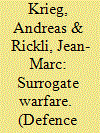

|
|
|
|
|
| Summary/Abstract |
Airpower, drones and cyber-weapons are employed by states in conjunction with local armed non-state actors in an effort to coercively intervene in the crises of the twenty-first century. While the externalization of the burden of warfare is a return to pre-modern war, it is the change in the underlying socio-political relations between the state and its military agent that is a novel phenomenon in surrogate warfare. This article demonstrates that in a post-Westphalian era characterized by non-state violence, globalized conflicts, a prioritization of risk management in a mediatized environment, the state has to explore new ways to remain relevant as the primary communal security provider. Thereby, the organization of violence has departed from the employment of the state’s soldier as the primary bearer of the burden of warfare to a mode of war where technological and human surrogates enable the state to manage the risks of post-modern conflict remotely. In this article, we conceptually explore surrogate warfare as a socio-political phenomenon within the context of globalized, privatized, securitized and mediatized war.
|
|
|
|
|
|
|
|
|
|
|
|
|
|
|
|
| 12 |
ID:
193784
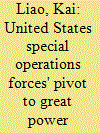

|
|
|
| 13 |
ID:
186968


|
|
|
|
|
| Summary/Abstract |
How do state sponsors of proxy groups in civil wars balance their support of non-state militias with the need for political transition towards stability? This article explores the inconsistencies in Iran’s priorities and proxy strategy that at times limited Iranian influence, and complicated Iraq’s transition from war to peace. It expands on current theories on proxy warfare by focusing on the impact of diverging interests among foreign policy elites in a sponsor state. Three policy dilemmas illustrate the difference among on the one side the Revolutionary Guard and on the other side the Ministry of Foreign Affairs and Ministry of Intelligence. First, whether the pro-Iranian proxies should maintain their influence after the war or Iran should strengthen its link to the representatives of the formal state. Second, whether repression by Shia militias or political reconciliation should prevent Sunni Arabs from (re)joining Islamic State. Third, whether Iraq should be part of a sectarian, transnational alliance or an inclusive state that might become an arbiter to deescalate regional tension. The study contributes to the literature on Iranian proxy warfare in the Middle East and proxy warfare literature in general, by considering the consequences of differences among foreign policy elites.
|
|
|
|
|
|
|
|
|
|
|
|
|
|
|
|
| 14 |
ID:
100413
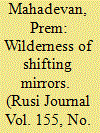

|
|
|
|
|
| Publication |
2010.
|
| Summary/Abstract |
Western counter-intelligence suffered a massive reputational loss on 9/11. Although many of the risks remain the same, the next decade is likely to see the increasing incidence of 'grey area phenomena': the convergence of subversive threats in ungoverned spaces. Better counter-espionage will be required to tackle cyber-attacks and information asymmetry, whilst some threats - such as the crime-terror nexus and proxy warfare - will require enhanced investment across the whole range of counter-intelligence capabilities.
|
|
|
|
|
|
|
|
|
|
|
|
|
|
|
|
|
|
|
|
|